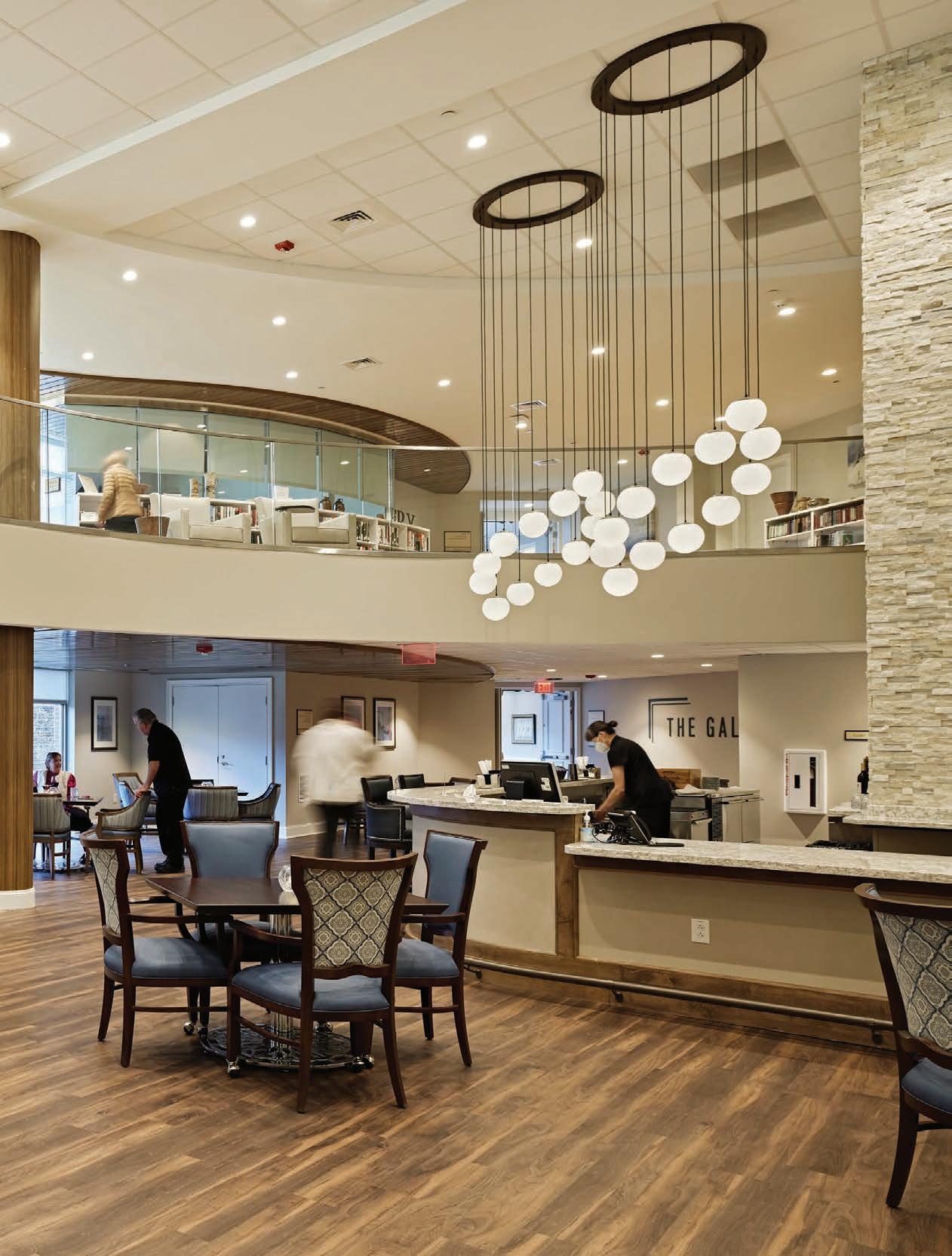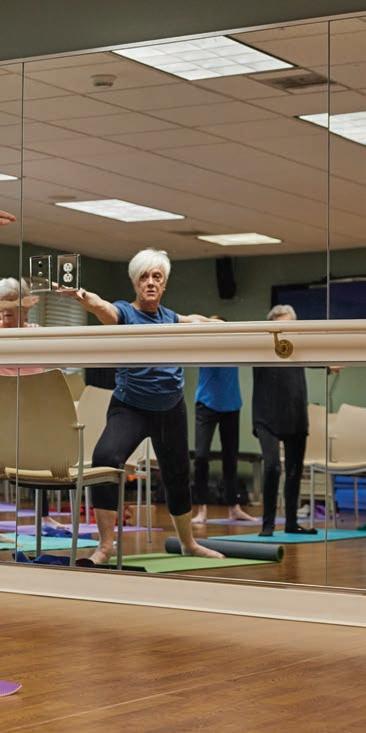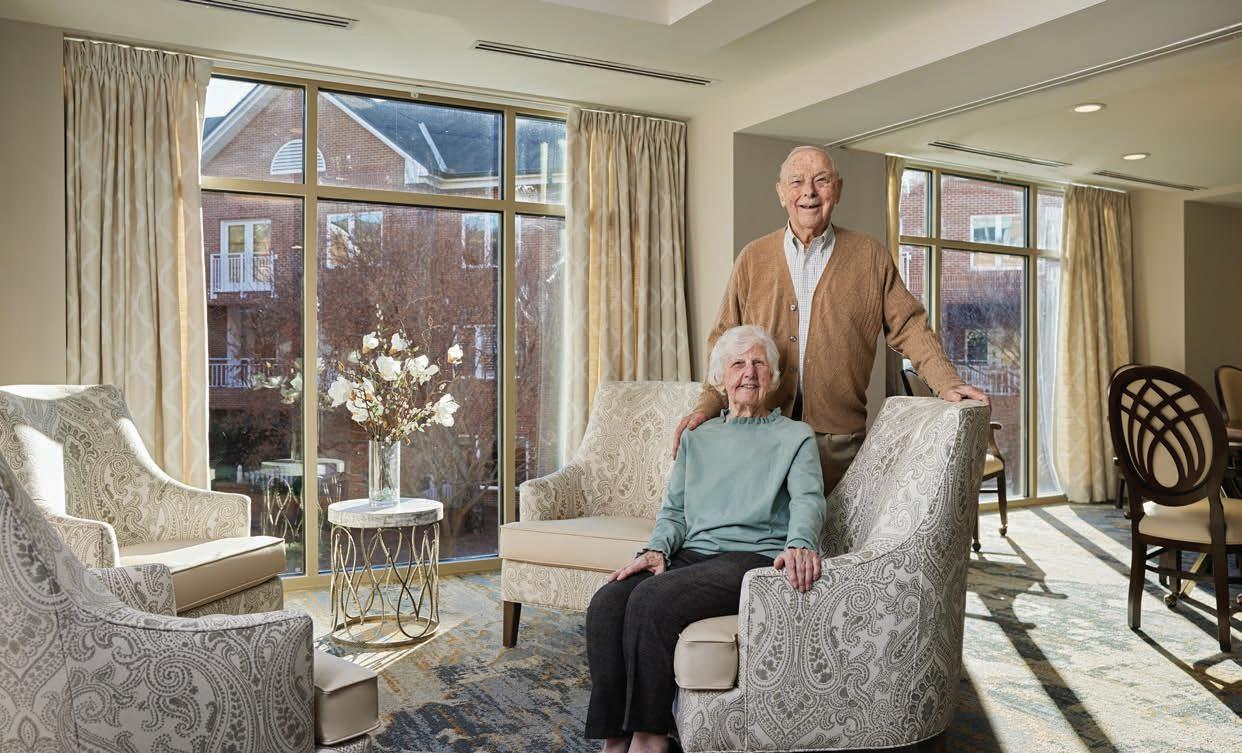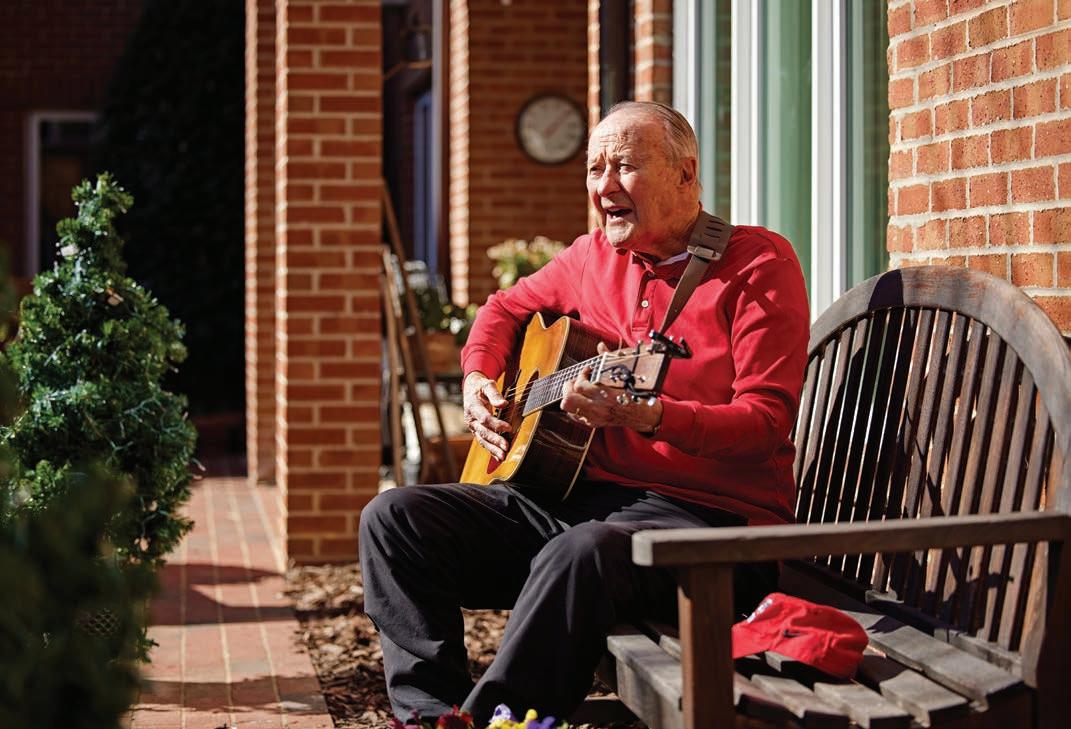
15 minute read
NEW LIFE
BY TAYLOR BOWLER New LifePHOTOGRAPHS BY RUSTY WILLIAMS
The Loft Library overlooks Lola’s Bar, where residents gather for live music, drinks, and dancing.
The core of the baby boomer generation is reaching retirement age, and that’s driving an emerging trend in Charlotte and elsewhere: Communities with more space, more options, more technology, more fun. Southminster is a growing community in south Charlotte where retirement living emphasizes the ‘living’

OON THURSDAY MORNINGS around 10:30, the entrance of Southminster’s wellness center buzzes with chatter. Twenty residents gather outside the aerobics room, gabbing about grandchildren and upcoming trips to Florida, until Carol Arnold opens the doors and ushers everyone in. The 79-year-old sets up chairs and yoga mats, and she moves with the ease of someone half her age. “Did everybody notice Sue’s new shirt?” she says as she pulls out her iPhone to nd her playlist. “It’s so stylish!” The class consists mostly of women. But a man stands in the front row, on the mat closest to the window: Tom, Carol’s husband of eight months. “Tom has a bit of stage fright,” Carol says with a grin. As the ambient music kicks on, she closes her eyes and takes a deep breath. “Good morning, and welcome to Standing and Seated Yoga.” She tells the class to plant their feet on the oor, establish good posture, and become aware of their breath. “Bring new life into your body and remove the old with each exhalation,” she says. “Feel your body and mind relax.” For the next 45 minutes, she leads them through warrior pose, downward-facing dog, and swan dive. With her hands propped on the chair, she demonstrates a modi ed plank. Tom, 80, struggles a bit with his barefooted tree pose but rarely takes his eyes o Carol. Not long ago, people like Tom, Carol, and their neighbors wouldn’t have been practicing their planks. Times have changed. Here, people in their 70s and 80s do yoga, perform water aerobics in the indoor pool, and attend dance parties at an on-site bar called Lola’s. One thing you absolutely do not call Southminster, or any of the expanding communities like it in Charlotte, is an “old folks’ home.”
“Our residents don’t see themselves living in a nursing home or assisted living,” says Stewart Wiley, director of sales and marketing for Southminster, which occupies 27 acres near Quail Hollow Club. “This generation of senior adults is not like prior generations. They act and dress younger, they view themselves as younger, and they’re much more active.”
As the class emerges from their savasana, Carol stands up, brings her hands to heart center, and signals the end of class with a “namaste.” In the back row, someone says, “Is it time for drinks?” Another replies, “Lola’s doesn’t open ’til four!”


Carol Arnold (top, in dark blue shirt), a longtime instructor at the Harris YMCA, teaches Standing and Seated Yoga at Southminster’s Embrace Wellness Center.

—STEWART WILEY, director of sales and marketing for Southminster
SOUTHMINSTER OPENED IN 1987 with about 130 apartments in one main building. Residents had a choice of only three standard oor plans you’d nd in a traditional assisted or independent living community.
Southminster’s newest apartments range from 1,400 to 2,000 square feet. Wiley calls them “hybrid villas,” and they boast high ceilings; built-in shelves; French doors; zeroentry shower stalls; private, covered patios and balconies; and access to underground, secured parking. “They’re like a cross between an apartment and a cottage because you have natural light coming in almost every room, but they have a custom feel to them,” he says. “They’re the rage in senior housing.”
A complex that used to occupy a single building has grown through four major expansions. Stroll through the lobby of one of Southminster’s four new apartment buildings, and you’d think you were in a SouthPark high-rise. Sleek pendant lights hang from high ceilings, and oor-to-ceiling windows let sunlight ood the common areas. The entrance fees range from $130,000 to $960,000. Monthly fees cover amenities like weekly housekeeping, wireless internet, groundskeeping, and 24-hour security, and range from $3,600 to $6,600. Wiley recommends residents have net assets that total at least three times the entry fee.
Enter the main building, and you’ll pass a game room, library, tness center with an indoor pool, and stadium-style movie theater. Residents catch up over glasses of wine at Lola’s, walk their dogs in the courtyard, and scroll through photos of their grandchildren on their smartphones. Long-term providers and researchers have worked in recent years to update the terminology associated with senior care. People who live at Southminster are “residents,” not “patients,” and the spaces where they live are “units,” not “beds.”
The changes, physical and verbal, re ect a large-scale generational shi . The oldest of the baby boomers hit 65 a little more than a decade ago. The heart of the generation, people born in the mid-to-late 1950s, is reaching it now. Charlotte continues to be a popular retirement destination, and communities have grown to accommodate people who have chosen to move into places like Sharon Towers on Sharon Road, which houses 330 residents, and Aldersgate on Shamrock Drive in east Charlotte, which has undergone 10 expansions since it opened in 1946.
They and Southminster re ect a national trend of retirement living for seniors who don’t want the hassle and upkeep of homes that no longer suit them. Most of Southminster’s roughly 450 residents aren’t “put” here by their adult children, and many aren’t even retired yet. They don’t require assisted living or skilled nursing, although Southminster o ers both should their needs change. More and more residents are choosing these life plan communities (also known as CCRCs, or continuing care retirement communities), which allow them to live independently but not in isolation.
In 2020, Southminster completed a three-phase, $120 million expansion that included a 200,000-square-foot medical facility and 66 new residences. Southminster had been fully occupied for about four years prior to the groundbreaking, and their waitlist doubled in that time.
“It was like a freshman class of students moving here in summer 2020, at the height of COVID,” Wiley says. Between March 2020 and May 2021, 108 new residents moved in. “We have a waitlist with nearly 700 names, but COVID has altered that. People are getting on the waitlist much sooner.” Some add their names because they’re thinking ahead to the time they know is coming; others want a unit as soon as one comes available. Some want a one-bedroom apartment; others prefer the two-bedroom cottages. “Depending on what one is looking for,”

he says, “the wait could be as little as one year to over ve.”
The rapid graying of the baby boomers, a phenomenon sometimes dubbed the “silver tsunami,” drives the demand. The U.S. Census Bureau projects the senior population will grow by 30 million within the next eight years— which means 20% of the population will be 65 or older by 2030, compared to about 13% today. “We’ll have more people over 65 than under 18 for the first time in U.S. history,” says Rodney Harrell, a vice president at the AARP Public Policy Institute.
About 1 million Americans lived in some type of senior living community in 2019, according to the National Center for Assisted Living; that number is expected to double by 2030. The American Health Care Association reports 28,900 assisted living communities in the U.S., but CCRCs like Southminster are a more specialized category. AARP reported 2,000 CCRCs nationwide as of 2019, up from about 900 in 1993. Charlotte, home to more than 62,000 seniors, has six. A 2014 UNC Chapel Hill study found that North Carolina’s 57 CCRCs served about 19,000 residents—and projected that number would rise to 35,000 by 2034.
People traditionally have lower incomes a er they retire. The most recent retirees are di erent, says Karan Kaul, a principal research associate at the Urban Institute’s Housing Finance Policy Center. The strength of the stock market in the years a er the Great Recession le many with a surplus of investment income, and COVID has curtailed their spending habits. “With people not going out, not traveling, and getting stimulus payments, it gave their savings a decent bump,” he says. And in the pandemic economy, most prospective CCRC residents have easily sold their homes or cashed out their home equity to cover the entrance fee.
As more boomers move into retirement age—the last were born in 1964—they’ll continue to shape the U.S. housing market. If enough boomers move to senior living communities, will it free up family housing for the next generation of homebuyers, the smaller Generation X? Will the explosion in CCRCs today lead to empty units by the time Gen Xers turn 65?
Newlyweds Carol and Tom Arnold exchanged vows at a small ceremony at Lake Norman last May.
TOM AND CAROL ARNOLD, the yoga-class couple who predate the boomers, encountered the opposite problem when they decided they wanted to live in Southminster. “Our apartment,” Carol says, “was just a hole in the ground when we rst saw it.”
The Arnolds met in 2017, when their cousins introduced them. Carol already lived in Charlotte to be close to her daughter. Tom lived in Virginia Beach but decided Charlotte was near enough to his son in Winston-Salem. They considered buying a house or condo, Carol says, but “a retirement community made sense at our age.”
Once they were engaged, the couple looked at Sharon Towers and The Cypress, two miles up Park Road from Southminster, but liked Southminster most. The only hitch: The expansion wasn’t nished. They bought—sight unseen—one of the two units no one had reserved and worked with the builder to choose countertops, tiles, and hardware. They moved into their two-bedroom, 1,600-square-foot apartment in summer 2020. A little less than a year later, they were married.
Their biggest surprise has been an active social life, even during a pandemic. When the Arnolds rst moved in, meals had to be delivered to their rooms. But they’d gather in the courtyard for happy hour every evening until the food carts showed up and everyone dispersed to their apartments for dinner. “It was like freshman year,” Tom says. “You’re bonded forever.”
The Arnolds’ classmates consist of people who led full and fascinating lives before they got to Southminster. Tom’s a farmer from Virginia, and Carol’s a longtime teacher and yoga instructor. In the courtyard or dining room, they’re likely to run into Larry, a former attorney who plays guitar, or maybe Richard, who developed Pringles potato chips, or Ted and Bonnie, actors who have just returned from a lm shoot in Atlanta.
Richard Darragh and his wife, Mildred, are the resident sweethearts. They’ve been married 68 years and share ve children, 12 grandchildren, and 14 great-grandchildren. They’re natives of Montreal—Richard, 91, is French Canadian. He spent 36 years at Procter & Gamble, where, in addition to his Pringles achievement, he developed the spreadable consistency of Jif peanut butter and perfected Duncan Hines cake mixes.
A er Richard’s retirement at 62, the Darraghs lived in New York, Ohio, Florida, and Tennessee before they settled in Charlotte, where one of their daughters lives. “In Nashville, we had two years of bad health,” Mildred says, “so the kids got anxious with us there without family.” Southminster won out over retirement communities in Nashville and Greenville, South Carolina, where one of their sons lives, because of its superior medical facilities.
Those proved critical. Mildred developed a kidney infection that required emergency surgery in 2020. Then, last October, she su ered a stroke and spent a week in the hospital in Pineville, although she was able to return home to continue her physical therapy. “I feel a lot safer here,” she says. “The care we’ve gotten here has been superb.”
Now that Mildred is on the mend, the Darraghs are back to catching up with their neighbors in a place that’s more social than they’d ever imagined. “I thought I’d be hanging around with old people in wheelchairs,” Richard says. “But I’ve been pleasantly surprised. The residents are so interesting and so interested. We have great conversations all the time.”
It helps when you share an apartment complex with a lawyer. Larry Dagenhart, 89, was an attorney for McGuireWoods for 60 years. Dagenhart and his wife, Sarah, lived in their Eastover home for 50 years until they decided to downsize and move to Southminster in 2012. They’d watched their oldest daughter move her in-laws into assisted living and decided they would never
Richard and Mildred Darragh (pictured here in Southminster’s private dining room) moved into their apartment in July 2018 after a ninemonth renovation they supervised. burden their three adult children with that task. “My wife and I agreed we should come here when we could still walk—or jog—through those doors,” Larry says. “She said this was a gi to our children.”
Larry wanted a ground-floor apartment with a patio for a garden. None of the units had enough space, so he purchased two and combined them. He and Sarah moved in a er a nine-month renovation, and he built a longitudinal garden on the expanded patio. “It’s mostly owers, and I grow veggies in winter to ll up the space,” he says. “I try to have something blooming most of the year.”
Sarah died in 2020. Larry lls his days by tending his garden, playing guitar, and singing. He and his neighbors get together on Sunday nights to catch up and listen to Larry play his guitar. “I play three chords and sing loud,” he says with a laugh. “You can sing over a chord you don’t know.”
SOUTHMINSTER CONTINUES to grow, not just in square footage but with residents who still have stories to tell and things to do. Its next expansion, which it calls Top of East, is a $20 million renovation that administrators expect to be complete in December.

—BONNIE JOHNSON
Ted and Bonnie Johnson keep binders filled with old call sheets, ticket stubs, and Polaroids from various movie sets.




Top of East includes 20 new apartments, each with its own floor plan. Units range from 1,400 to 3,000 square feet, with fully equipped kitchens, stainless steel appliances, and iPads where residents can order meals, nd the community event calendar, and see who is celebrating a birthday that day. Hybrid villas will come equipped with a system that alerts sta to falls, and the campus will have more landscaped courtyards, three re pits, a pickleball court, and a putting green.
For Ted and Bonnie Johnson, all these niceties are a stark contrast to the type of place they might have landed in a generation ago, when people in their 80s were o en treated as if their lives were already over. “My mother always said, ‘Don’t put me in a nursing home,’ but then she fell and broke her hip,” Bonnie says. “She had to go into one of those places with a bed, a bathroom, and a TV, and she was miserable.”
Today, Ted and Bonnie live in a twobedroom apartment where the hallway is lined with movie posters and behindthe-scenes photos from films and TV shows they’ve appeared in over the last three decades. A shot of Bonnie with her stunt double on the set of the Net ix series Ozark hangs beside a poster of Sleeping with the Enemy, one of her rst feature lms. In the o ce, Ted displays photos from his stint in Leatherheads, including a candid shot of George Clooney from the set. On an adjacent wall is a collage from the Lincoln shoot, where he played Governor John W. Ellis of North Carolina.
The Johnsons moved to Southminster in 2013 a er 17 years in their home in Ivy Hall, a gated community in south Charlotte. Ted and Bonnie, who each have two adult children from previous marriages, toured ve retirement communities in Charlotte and narrowed it down to three when a spot at Southminster opened up. “We thought it would be a ve-year process,” Ted says, “so we got on waitlists before we were ready.”
They knew the real estate market was good, but even they were surprised when their house sold in one day. Bonnie took it as a sign. Their 1,600-square-foot apartment in Southminster’s main building, recently vacated by a tenant who’d moved to skilled nursing, has a big primary bedroom with a blank wall where they can shoot their audition videos.
Bonnie, now 80, spent her career as an executive secretary but began acting in lms when she moved to Charlotte in the 1980s. Most recently, she appeared in the Hulu miniseries Dopesick, which stars Michael Keaton. Ted, 83, worked in banking most of his life and began acting a er he married Bonnie in 1996. “I never did a stitch of acting in high school,” he says.
On a given week, the couple might audition for a television pilot over Zoom or drive to Chattanooga for a lm shoot. When one of their movies or TV shows premieres, Southminster hosts a special screening in the theater. Ted and Bonnie introduce the lm or show, talk about the shoot, and answer questions. “Residents wanted less goodygoody movies; they wanted more R-rated things in the lineup,” Bonnie says. “I think that’s why they showed Dopesick.”
When we talk in February, she and Ted are preparing to shoot a web commercial in Tallahassee, which reminds her: They’ll need to alert the sta that they’ll be away. She walks to the kitchen, where the iPad is propped in its charging dock, and swipes le to send o a quick message. Then she taps the day’s schedule to see what’s happening at Lola’s tonight.
Larry Dagenhart plays guitar for his neighbors on Sunday nights. “I do country and gospel and campfire songs,” he says. “I get them all singing.”



